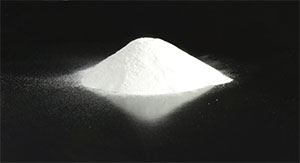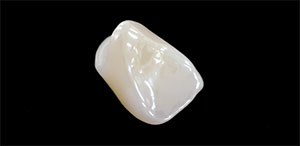By the time it reaches dental labs and offices, the result is an unassuming white blank – a puck or block ready for milling. Most don’t realize the intensive process that goes into manufacturing the KATANA material. Kuraray Noritake Dental (KND) maintains a unique process that manufactures zirconium dioxide (Zr02) powder to block or disc. (Fig1 – with image of disc & block) It is important to understand that “both composition and powder particle size affect the ceramic microstructure, which dictates the mechanical and physical properties of zirconia.” (John O. Burgess, DDS, MS. Oct442018. Zirconia: The Material, Its Evolution, and Composition. Compend Contin Educ Dent. Vol 39, Supplement 4; pg 4-8).
It all Begins with the Y(ttria)
The element zircon is mined and purified before it is turned into powder and eventually pressed. In its first iteration, zirconia which contains no glass, appeared opaque and low in translucency but high in mechanical strength. Therefore, it was used successfully for copings and long-span frameworks. Demand for monolithic and metal-free material grew, thus paving the way for better looking material. Research and technology developed a method to manipulate zirconia (Zr02) which is a polycrystalline structure composed of crystals. High temperatures and the addition of yttria oxide changes the atomic arrangement within the crystals into three polymorphisms: monoclinic, tetragonal, and cubic forms. The composition of powder greatly affects translucency within the crystals to result in the bending or refraction of light. Tetragonal grains if not aligned, reflect at grain boundaries and scatter light, resulting in opacious optics. In comparison, cubic grains allow light to travel through the grain, for more translucence.

Additionally, manipulating the atomic arrangement within the crystals of zirconia affects its mechanical properties. On one end of the spectrum, zirconia may yield greater translucency, however it generally reduces the mechanical strength, and vice versa. Zirconia is generally identified under the three categories based on its yttria content: 3, 4, or 5 mol%. It seems easier to generalize the characteristics of a material by these categories, with 3 mol% being the strongest but also the most opacious, and 5 mol% as most translucent but weakest. However, the mixture of powder types in a blank is just one of many factors to consider. To know the yttria content of a zirconia blank is not sufficient information if we do not appreciate how exhaustive the entire process to turn the element zirconia, into a useable dental material.
Why KATANA?
Kuraray Noritake Dental (KND) was formed by the merger between a leader in resin/adhesive manufacturing Kuraray, and Noritake, a highly respected name in ceramics. Naturally, the merger of Kuraray and Noritake in 2012 brought together the expertise that introduced KATANA Zirconia. KND is unique in their decision to control the end-to-end process of manufacturing of KATANA zirconia. While most other zirconia block manufacturers purchased their powder from third party suppliers, such as Tosoh Corp., KND maintains strict regulation over each process. From purification and refining, to the addition of oxides and binders, to the molding and pressing, “the outcome of this total process are translucency, shade appearance, flexural strength, ageing behaviour, and sintering performance” (M. Fernandez y Lombardi. KATANA Zirconia – The Science Behind Superior Product Properties. Dent Tribune International Vol2. Issue 2/2021. 34-37).

KATANA was first introduced to dental labs in 2007. KND was the first to come to market with chromatic multi-layer technology, a powder pigmentation technique in 2013. This unique manufacturing process resulted in a seamless transition or having no gradation gaps, amongst the four layers of varying chroma giving a natural lifelike appearance. Still, the material maintains its mechanical properties with the addition of this esthetic feature. The KATANA line diversified their translucency offerings by way of Ultra Translucent Multi Layer (UTML) and Super Translucent Multi Layer (STML) pucks.

In 2018 the introduction of KATANA STML further expanded its market share as blocks were introduced to chair-side applications. The KATANA block offers a great balance of strength that conventional zirconia offers, and the esthetics that clinicians were accustomed to from traditional ceramics. The technology of CAD/CAM system, CEREC by DentsplySirona makes it possible to fabricate zirconia restorations for single-visit dentistry. The technology makes it possible to mill the block in less than five minutes and sinter predictably sinter in 18-minutes. The result of the material and the technology is a testament to the high quality that Kuraray Noritake Dental creates the KATANA STML material with. “The company can thereby more accurately control the chemical and physical makeup, not only with Yttria concentration, but parameters like grain or particle size, as well as sintering temperature.” (D. Sinha, BDS, PhD. J of Dent Technology. Nov/Dec 2021)